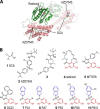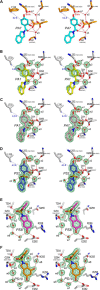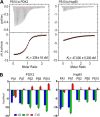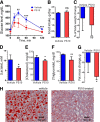Structure-guided development of specific pyruvate dehydrogenase kinase inhibitors targeting the ATP-binding pocket
- PMID: 24356970
- PMCID: PMC3924305
- DOI: 10.1074/jbc.M113.533885
Structure-guided development of specific pyruvate dehydrogenase kinase inhibitors targeting the ATP-binding pocket
Abstract
Pyruvate dehydrogenase kinase isoforms (PDKs 1-4) negatively regulate activity of the mitochondrial pyruvate dehydrogenase complex by reversible phosphorylation. PDK isoforms are up-regulated in obesity, diabetes, heart failure, and cancer and are potential therapeutic targets for these important human diseases. Here, we employed a structure-guided design to convert a known Hsp90 inhibitor to a series of highly specific PDK inhibitors, based on structural conservation in the ATP-binding pocket. The key step involved the substitution of a carbonyl group in the parent compound with a sulfonyl in the PDK inhibitors. The final compound of this series, 2-[(2,4-dihydroxyphenyl)sulfonyl]isoindoline-4,6-diol, designated PS10, inhibits all four PDK isoforms with IC50 = 0.8 μM for PDK2. The administration of PS10 (70 mg/kg) to diet-induced obese mice significantly augments pyruvate dehydrogenase complex activity with reduced phosphorylation in different tissues. Prolonged PS10 treatments result in improved glucose tolerance and notably lessened hepatic steatosis in the mouse model. The results support the pharmacological approach of targeting PDK to control both glucose and fat levels in obesity and type 2 diabetes.
Keywords: Diabetes; Drug Development; Enzyme Inhibitors; Glucose Metabolism; Hepatic Steatosis; Mitochondrial Protein Kinase; Pyruvate Dehydrogenase Complex; Pyruvate Dehydrogenase Kinase; Structure-based Inhibitor Design.
Figures








Similar articles
-
Targeting hepatic pyruvate dehydrogenase kinases restores insulin signaling and mitigates ChREBP-mediated lipogenesis in diet-induced obese mice.Mol Metab. 2018 Jun;12:12-24. doi: 10.1016/j.molmet.2018.03.014. Epub 2018 Mar 31. Mol Metab. 2018. PMID: 29656110 Free PMC article.
-
A novel inhibitor of pyruvate dehydrogenase kinase stimulates myocardial carbohydrate oxidation in diet-induced obesity.J Biol Chem. 2018 Jun 22;293(25):9604-9613. doi: 10.1074/jbc.RA118.002838. Epub 2018 May 8. J Biol Chem. 2018. PMID: 29739849 Free PMC article.
-
Development of Dihydroxyphenyl Sulfonylisoindoline Derivatives as Liver-Targeting Pyruvate Dehydrogenase Kinase Inhibitors.J Med Chem. 2017 Feb 9;60(3):1142-1150. doi: 10.1021/acs.jmedchem.6b01540. Epub 2017 Jan 31. J Med Chem. 2017. PMID: 28085286 Free PMC article.
-
Therapeutic Targeting of the Pyruvate Dehydrogenase Complex/Pyruvate Dehydrogenase Kinase (PDC/PDK) Axis in Cancer.J Natl Cancer Inst. 2017 Nov 1;109(11). doi: 10.1093/jnci/djx071. J Natl Cancer Inst. 2017. PMID: 29059435 Review.
-
Targeting pyruvate dehydrogenase kinase signaling in the development of effective cancer therapy.Biochim Biophys Acta Rev Cancer. 2021 Aug;1876(1):188568. doi: 10.1016/j.bbcan.2021.188568. Epub 2021 May 21. Biochim Biophys Acta Rev Cancer. 2021. PMID: 34023419 Review.
Cited by
-
Pyruvate Dehydrogenase as a Therapeutic Target for Nonalcoholic Fatty Liver Disease.ACS Pharmacol Transl Sci. 2021 Mar 3;4(2):582-588. doi: 10.1021/acsptsci.0c00208. eCollection 2021 Apr 9. ACS Pharmacol Transl Sci. 2021. PMID: 33860188 Free PMC article. Review.
-
Pyruvate Dehydrogenase Kinase Inhibition by Dichloroacetate in Melanoma Cells Unveils Metabolic Vulnerabilities.Int J Mol Sci. 2022 Mar 29;23(7):3745. doi: 10.3390/ijms23073745. Int J Mol Sci. 2022. PMID: 35409102 Free PMC article.
-
A Missense Variant in PDK1 Associated with Severe Neurodevelopmental Delay and Epilepsy.Biomedicines. 2022 Dec 7;10(12):3171. doi: 10.3390/biomedicines10123171. Biomedicines. 2022. PMID: 36551928 Free PMC article.
-
Exploring PDK3 inhibition in lung cancer through drug repurposing for potential therapeutic interventions.Sci Rep. 2024 Nov 29;14(1):29672. doi: 10.1038/s41598-024-78022-0. Sci Rep. 2024. PMID: 39613779 Free PMC article.
-
Inactivation of multiple bacterial histidine kinases by targeting the ATP-binding domain.ACS Chem Biol. 2015 Jan 16;10(1):328-35. doi: 10.1021/cb5008019. Epub 2015 Jan 8. ACS Chem Biol. 2015. PMID: 25531939 Free PMC article.
References
-
- Reed L. J. (2001) A trail of research from lipoic acid to α-keto acid dehydrogenase complexes. J. Biol. Chem. 276, 38329–38336 - PubMed
-
- Randle P. J. (1995) Metabolic fuel selection: general integration at the whole-body level. Proc. Nutr. Soc. 54, 317–327 - PubMed
-
- Harris R. A., Hawes J. W., Popov K. M., Zhao Y., Shimomura Y., Sato J., Jaskiewicz J., Hurley T. D. (1997) Studies on the regulation of the mitochondrial α-ketoacid dehydrogenase complexes and their kinases. Adv. Enzyme Regul. 37, 271–293 - PubMed
-
- Wu P., Inskeep K., Bowker-Kinley M. M., Popov K. M., Harris R. A. (1999) Mechanism responsible for inactivation of skeletal muscle pyruvate dehydrogenase complex in starvation and diabetes. Diabetes 48, 1593–1599 - PubMed
-
- Rosa G., Di Rocco P., Manco M., Greco A. V., Castagneto M., Vidal H., Mingrone G. (2003) Reduced PDK4 expression associates with increased insulin sensitivity in postobese patients. Obes. Res. 11, 176–182 - PubMed
Publication types
MeSH terms
Substances
Associated data
- Actions
- Actions
- Actions
- Actions
- Actions
Grants and funding
LinkOut - more resources
Full Text Sources
Other Literature Sources
Chemical Information
Medical
Molecular Biology Databases

